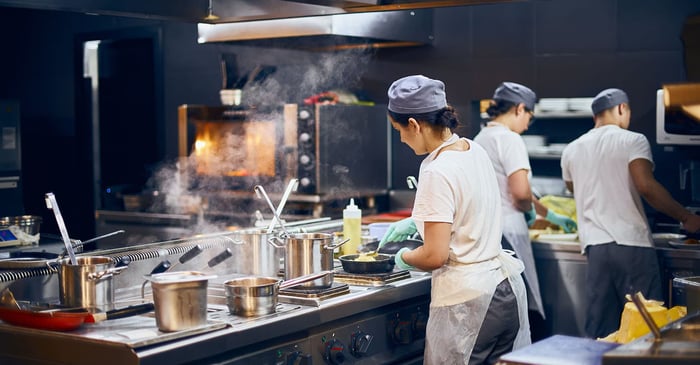2020 was a heartbreaking and terrifying period for hoteliers and restauranteurs around the world. The COVID-19 pandemic brought about a sudden wave of business closures, and restaurants were the most hit. People could no longer enjoy regular hotel services due to safety restrictions, so restaurant owners had to re-evaluate their operational models. Even though ghost kitchens had already started becoming a trend, the pandemic made them a necessity for entrepreneurs that still hoped to remain in business.
The digital revolution has made it to the hotel industry. With more people warming up to ordering in, it's no surprise that the online food delivery sector is expected to be worth a whopping $94 billion by 2024. Included in this developing sector is the ghost kitchen. But what exactly is it? How are micro-cloud kitchens developed? Should you integrate them into your business model? Here's the ultimate guide to ghost kitchens in 2021!
What is a Ghost Kitchen?
Ghost kitchens are also referred to as micro-cloud kitchens or virtual kitchens. They refer to restaurants that don't offer dine-in services. They are built to fulfil online orders, hence their menus are only available to customers that require delivery. Think of it as a co-working space. There are no tables or walk-in customers. You just rent a space, create a menu and start selling your food to online customers through third-party delivery apps.
Previously, ghost kitchens were mainly being used by virtual restaurants, however after the pandemic forced restaurant owners to cut down on operations or shut down, more chain restaurants have started adopting the concept. Some popular restaurants are toying with the idea of branching out into virtual kitchens, whereas others like Chick-fil-a have already embraced it.
How are Ghost Kitchens developed?
Ghost kitchens are based on the fundamental shift in consumer behavior that all restaurants have been experiencing; they reduce the costs associated with dine-in restaurants by capitalizing on the increase in online orders.
The beauty of ghost kitchens is that you're in control of most of the operational aspects other than delivery. You don't have to be located in a busy location, you don't have to employ wait staff and you can easily customize your menu so that it only focuses on food that is delivery-friendly.
You, however, have to create effective workflows and invest in quality packaging, which is a small price to pay.
Main types of Ghost Kitchens
Currently, there are 3 main types of ghost kitchens:
- Commissary/Shared kitchens: In this model, an entrepreneur rents the premises, installs the needed kitchen accessories, and then rents out to virtual restaurants. This model is fairly affordable because you don't incur the inflated startup costs, the rent is considerably lower and you'll have all the equipment you need.
Since these shared kitchens are often owned by resourceful business people or large corporations, they are usually in compliance with state building codes, food service regulations and OSHA laws, which are some of the most complicated aspects of owning a restaurant. The only major downside is that you may have to share the space with other restaurants. - Incubator/Pop-up kitchens: These types of kitchens are linked to regular restaurants but are only used for online orders and deliveries. With this model, you integrate delivery into your operations but separate the processes so that the dine-in staff isn't overwhelmed by the online orders.
This option is especially useful for existing restaurants looking for additional revenue streams and want to test the ghost kitchen concept. The best part is that you already have the restaurant space and equipment, so all you have to do is create the effective workflows. - Kitchen pods: Also referred to as "dark kitchens", they are quite simply containers fitted with kitchen accessories. A factory-made kitchen unit that comes pre-installed with mechanical, electrical, plumbing and appliances. Orders come in, food is prepared and packaged meals go out to the customer.
6 Reasons for integrating Ghost Kitchens into your business
Some of the reasons why ghost kitchens are blowing up include:
-
Reduced overhead costs
Since there are no dine-in customers, your overhead costs are significantly low. For instance, you don't have to buy tables, chairs or decorative elements. You also don't need wait staff or extra floor space, so operations are lean.
You only have to ensure that you meet the health standards of the Department of Health and that your permits are up to date. This gives you more time to work on your menu and streamline your delivery services.
-
Low startup costs
Generally, restaurant startup costs are extremely high. In addition to renting, furnishing and decorating your premises, you also have to buy kitchen equipment and hire employees. All these expenses combined can cripple your finances, especially now that the economy is just opening up.
Since you already have a restaurant, you won't have to incur any additional costs. You can use your existing equipment and split operations between your physical and virtual restaurants. For instance, even though customers can now have meals in restaurants, many of them are opting to order in. This means that operations still aren't optimal. Instead of letting some staff go, you can ask them to be part of the virtual kitchen. This way, you'll be able to run both business models with ease.
-
Ability to maximize workflows
Ghost kitchens allow you to focus on your restaurant's core objective. Trying to cater to both in-person and online orders using the same model will only leave you overwhelmed. If some of your staff are dedicated to online orders while others tend to your customers, you'll be able to optimize your operations.
Restaurants are often very busy, and if you're using one chef for your dine-in and online orders, the staff may end up plating meals meant for delivery. By integrating a ghost kitchen, staff will be able to focus on their area of specialization. There will also be fewer people in the kitchen area so your dine-in team can focus on delivering exceptional services to your customers.
-
Enhanced market penetration
The dynamics of running a restaurant are changing and ghost kitchens help you reach an untapped market audience. With brick-and-mortar restaurants, you have to provide your services within your physical location. This means that on days when the foot traffic is low, your revenue is also low.
Ghost restaurants, on the other hand, give you access to a wider audience, including those that are far away from your premises. All you need is a streamlined delivery system and you'll be able to increase your market share within a short time.
-
Ability to keep up with shifts in consumer behavior
The food delivery market revenue has increased by more than 200% within the last 5 years. Consumer preferences are changing, more people are leaning towards ordering-in due to the high levels of convenience it offers. By adopting a ghost kitchen model, you're able to keep up with modern delivery demands. This increases your revenue streams and enhances your agility.
-
Ability to dominate a food category
Ghost kitchens give you full control over your menu. You have the flexibility to change your cuisine instantly and you can test out various food options before settling on a particular category.
With brick-and-mortar restaurants, changing your cuisine means that you have to print other menus and let your customers know in advance. You also have to update your signage boards. With ghost kitchens, you simply change your restaurant's description on the app.
Once you've identified your preferred food category, you can then focus on perfecting your recipes so as to enhance your market dominance.
Practical tips on how to start a Ghost Kitchen
If you're certain that ghost kitchens are the best way to increase your revenue streams, here are a few tips to get you started.
- Take an inventory of the accessories and equipment you have. This will help you to assess whether you can start with what you have.
- Build a brand for your ghost kitchen. Identify the cuisines that people in your general area like best and then focus on a particular food category. Most people tend to order meals from specialized restaurants.
- Focus on suitability and simplicity, and create a basic menu. The main point of opening a ghost restaurant is to optimize your operations.
- Define your target audience. They could be your existing customers, in which case you can offer the same cuisine as your restaurant or new clientele.
- Make sure your tech capabilities can handle an online delivery system. Your ghost kitchen is highly dependent on how streamlined your deliveries will be, so optimize your technologies before you get started.
Is a Ghost Kitchen right for your restaurant business?
Yes! Ghost kitchens are undoubtedly the future. More people are using food delivery services, so it's wise to keep up with the current consumer trends. The recent pandemic is also enough proof that the business world is uncertain, and you shouldn't put all your eggs in one basket.
If you're looking to enhance your business management skills, we have a variety of courses that can help you sharpen your knowhow. Contact us today for help with your admission.






